原文发表于1994年Mesemb Study Group第九期会刊,原文作者Steven Hammer
图片来源:Chris Rodgerson.
文章、图片资料仅供学习,如有侵权请告知。
Originally published in the Journal Mesemb Study Group Bulletin, vol. 9 in 1994, the original author is Steven Hammer
Source: Chris Rodgerson.
Article, picture information is only for learning, if any infringement please inform.
(下文为本人初级英语翻译,多有错漏,请见谅)
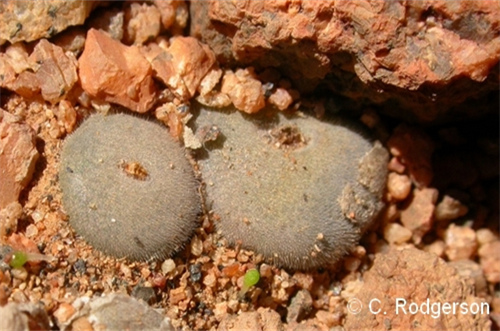
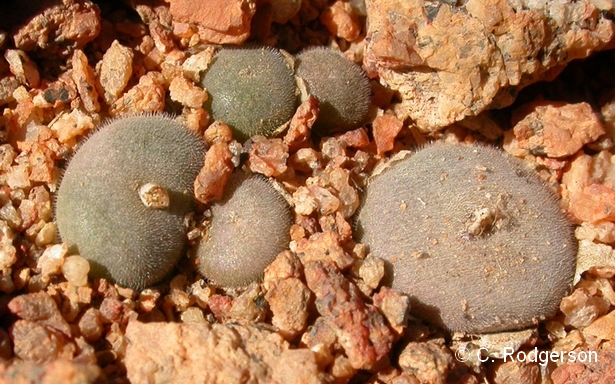
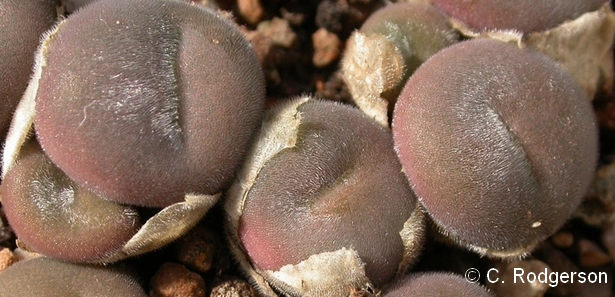
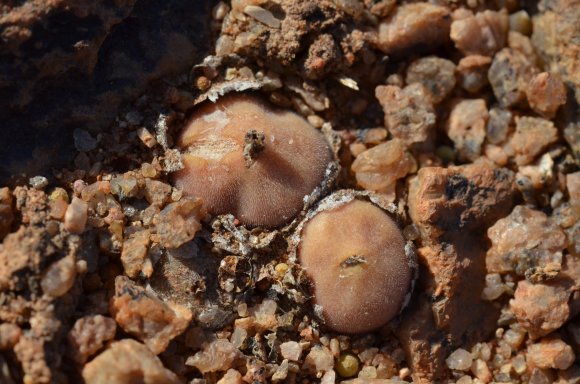
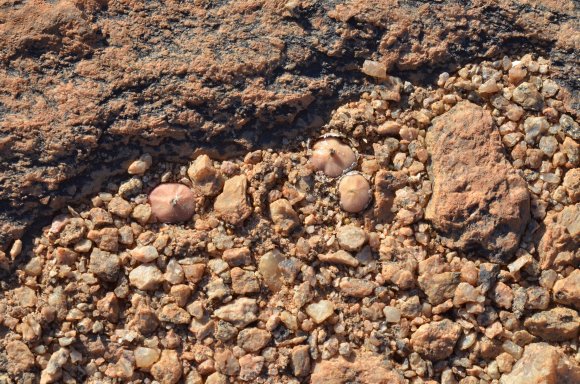
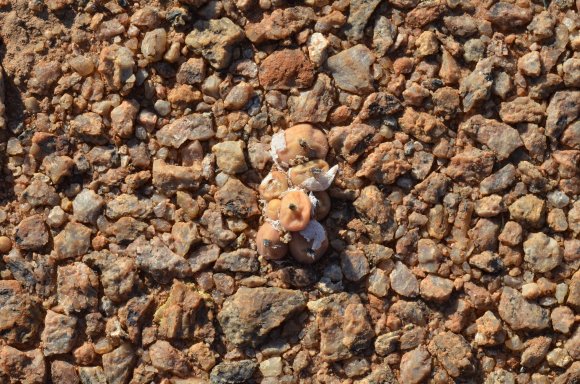

Conophytum depressum subsp. depressum R&Y1806 (Rooiwal, habitat)
When I was visiting the Smales in September, Terry got an amusing phone call. His caller – whose identity I did not know – had an unusual lament: he had too many seedlings of Conophytum depressum and C. angelicae and wondered just how he should dispose of this awkward largesse. Well! – I have known a few people who were too beautiful, and one who was too rich, and several who had an excess of suitors or talents; but this angelic and depressing problem astonished me.
9月份我拜访Smales先生的时候,Terry(TS的全名Terry Smales)正好接到了一个有趣的电话。他的呼叫者 (我不知道他的身份),有不寻常的悲叹︰ 他有太多播种的 Conophytum depressum(D毛球) 和 C. angelicae(烧卖) ,只是他不知道应该如何处理这种尴尬的慷慨。好!!我知道一些人长得太美(帅),太有钱,而且有过多的追求或天赋,但是这些depressum和angelic的数量确让我大为吃惊。
I should explain that I receive very large number of complaints about C. depressum. I hear that it does not germinate, or that a few specks emerge only to fall into the muck within days. Since I have hundreds of seedlings from half a dozen localities (including both the annual and perennial forms) I thought I should mention exactly how I manage it. Frank Distefano, who employs rather similar, but more reliable and scientific methods, has had great success with this species, and obviously Terry’s caller has done well.
我应该说明我收到非常大量关于depressum的抱怨。我听说它没有发芽,或者几只斑点出现几天内陷入淤泥。因为我有成百上千的幼苗从六个地区(包括年度和长期形式)我认为我应该提及如何管理它。Frank Distefano,他使用类似但更可靠和科学的方法,显然与这个物种已经成功,Terry的来电者已经做得很好。
Much of this will be redundant for people who have had good results, and some of it may not be transferable to other environments, but here goes. For the sowing medium, I use a combination of:
对于那些有好成绩的人来说,这将是多余的,其中一些可能不会转移到其他环境,但要开始了!对于播种介质,我使用的组合:
- 3 parts sterilized commercial sowing mix (i.e. the sort of fine-screened, “peat-lite” mixture of perlite, vermiculite, and peat moss, favoured by petunia and snapdragon growers) 3份消毒商业混播(即那种精细筛选,“泥炭Lite”混合珍珠岩、蛭石、草炭、矮牵牛、金鱼草种植者的青睐)
- 1 part perlite 1份珍珠岩
- 1/2 part loam baked in a moderate oven until fragrant 1 / 2部分壤土烤在一个温和的烤箱,直到香
- 1/2 part fine pumice (2-3 mm size) (vermiculite will do as a substitute) 1 / 2部分细浮石(2-3毫米大小)(蛭石可以作为替代)
- 1 part coarse sand. 1份粗砂。
Screen the mixture through a ca. 3 mm mesh. It should be slightly acid in reaction and essentially sterile. If in doubt, bake the whole lot. I use tiny plastic pots – 30×30×30 mm (small pots have definite advantages – they never get water-logged). I line the bottom few millimeters of the pot with a layer of pumice, fill it to the brim with the sowing mixture, topping it with finer material, tap it lightly, and wet it very thoroughly using the mist nozzle. The wetting may take five minutes or longer.
屏幕的混合物通过约3毫米网格。反应应微酸,基本无菌。如果有疑问,烘烤整个地段。我用小塑料罐- 30×30×30毫米(小壶有一定的优势-他们从来没有得到水记录)。我行的一层浮石锅底几毫米,填补它的边缘与播种的混合物,加上精细的材料,点击它轻轻的,湿的很彻底地利用雾化喷嘴。润湿可能需要五分钟或更长时间。
I sow the seeds, covering them not at all, and give the pots a saturating bath in a tub of lukewarm tap-water, temporarily displacing my collection of motorized frogs. I place the pots in tray, cover this with a plastic bag, and position the assemblage 8 inches below ordinary fluorescent lights. The lights, which occupy a hall kept at 65-70°F, glow for 13 hours a day. I check the moisture level every morning and evening; if there is any drying out at all, I have to move the frogs again.
我播下的种子,包括他们没有,把盆泡在一桶温自来水里让他饱和,暂时取代我的电动青蛙的收集。。我把盆放在盘子里,盖上塑料袋,在普通荧光灯下面放置8英寸的组合。光线,保持在65-70°F,一天13小时的光。我每天早晨和晚上检查水分水平,如果有任何干燥,我必须再次移动青蛙(搞不清楚青蛙是什么意思)。
After five days I uncover the pots, whether or not germination has occurred. I then initiate a thrice-daily misting with distilled water, and have a fan wafting gentle zephyrs through the hallway. Seedlings come up in about 7-10 days usually erratically – a bold few appear, then they are joined by their timider siblings and finally there is a crowd. At this point I switch to misting with weak fertilizer water. I mist at least twice daily (Frank has an automatic mist system, which bursts forth much more often) and I make sure that the pots never really dry out.
For at least the first month it is essential to promote the most rapid growth possible. The cotyledons of C. depressum are extremely small, but within two months they will exceed the size of pinheads if fed correctly. If you do not believe in feeding seedlings, forget your prejudices and try an experiment for once, or use a richer mix to begin with.
五天后我揭开花盆,检查是否有发芽发生。然后我开始每天三次雾化蒸馏水,并有一个风扇制造出柔和的西风吹向走廊。幼苗出现在7-10天左右通常不稳定–开始发芽的很少,然后他们的小兄弟姐妹们慢慢发芽,直到变成一大群。在这个时间段我切换到弱肥水喷雾。我每天至少喷两次水(Frank有一个自动喷雾系统,它会爆发得更频繁),我确保这些盆永远不会干涸。至少在第一个月,促进最快的增长是必要的。C.depressum的子叶是非常小的,但在两个月内如果养法正确,他们将超过针头大小。如果你不相信这种种植幼苗的办法,忘记你的偏见,尝试一次实验,或使用更丰富的混合种子来开始。(注:作者的英式幽默)
-------------------------翻译至此,太累了我要吃果去了,以下为百度翻译(亲,做人不能这么懒)-----------------------
I continue the daily feeding process for as long as I can get away with it. Seedlings from a December 1992 sowing showed their true lentil- leaves the following March. In April I moved them to the cool floor of the greenhouse. They went papery dormant in May but woke up early in July. I then transplanted them into 4-inch pots, the bottom halves of which were lined with pumice (in these “large” pots one must beware of rot), 25 to a pot. The plants responded well but did not show great activity until October, when they glossed over and began to flower (they are still at in early December).
我继续每天的喂养过程,只要我能逃脱它。从1992十二月播种幼苗真叶以下3扁豆。四月,我把他们搬到了温室的凉爽的地板上。他们去了纸质的休眠可以但醒来早在七月。我再将它们移植到4英寸的锅,其下半部布满浮石(在这些“大”盆必须提防腐),25锅。植物的反应良好,但没有显示出极大的活动,直到十月,当他们掩饰开始花(他们仍然在十二月初)。
I might mention that the same techniques work for any touchy conos — C. turrigerum, C. rugosum, etc. — and are also effective with small tylecodons and anacampseros, particularly A. bayeriano. In other words, light fixtures used in domestic environment have virtues which are difficult to duplicate in an ordinary greenhouse. On the other hand, one must beware of cats (or rabbits in my case; I once had a big flop-eared bunny named Fudgeberry who visited my lights and ate only rare things, devouring, for example, my first C. blandum. It seemed truly rare then!).
我可以说,同样的技术工作,任何敏感技友C turrigerum,C. rugosum,等,也是有效的小tylecodons和anacampseros,特别是A. bayeriano。也就是说,在家用环境中使用的灯具,在普通温室中具有难以复制的优点。另一方面,我们必须提防猫(或兔在我的情况下;我曾经有一个大耳朵下垂的兔子名叫Fudgeberry,谁访问了我的灯,只吃了难得的事情,例如,我第一次吃,blandum C.。那时看来真的很少见!)。

Conophytum depressum subsp. depressum R&Y1806 (Rooiwal, in situ)
But back to C. depressum for a moment. Both the "annual" and "perennial" forms behave well under lights, though the annuals will be smaller and a bit more tender at all stages. I should really call them quasi-biennals, for they often die after their first flowering, be that at one or two years. They also have smaller, less committed flowers which often resort to selfing. In this category I would place:
Kamieskroon, Die Kruis, Witwater, Springbok et Kosies.
但回到C. depressum一会儿。无论是“年”和“永恒”的形式表现的灯光下,虽然年会更小,更在所有投标阶段。我真的应该叫他们准biennals,他们往往死后他们的第一次开花,是在一年或两年。他们还小,少犯花,常常用自交。在这个类别中我会放置:Kamieskroon, Die Kruis, Witwater, Springbok et Kosies.

Conophytum depressum subsp. perdurans MG.1411.15 (Rietfontein, in situ)
The "perennial" forms [now described as Conophytum depressum subsp. perdurans] last for many years, mound up ala C. stephanii, and produce very long-lasting, strictly outcrossing, flowers. I only know this form from two adjacents farms, Rietfontein (see above) and Silverfontein, the same territory occupied by the transition forms between C. pellucidum var. neohallii and subsp. cupreatum. A part of this complex extends down to Rooifontein — I wonder if C. depressum grows there as well?
“常年”形式[现在称为Conophytum depressum subsp。perdurans ]持续很多年,丘协会C. stephanii,产生持久的、严格的异花授粉,花。我只知道这两种形式从农场、里特方丹(见上图)和Silverfontein,C.透明neohallii变种和亚种之间的过渡形式占据同一地区。cupreatum。这种复杂的一部分延伸到rooifontein -我不知道C.低沉生长在那里吗?
Mesemb Study Group Bulletin, vol. 9, n°2, 1994.
New pictures, with courtesy of Chris Rodgerson.



本博客所有文章如无特别注明均为原创。作者:AndyHuang ,复制或转载请以超链接形式注明转自 AndyHuang的番杏大杂烩 。
原文地址《Conophytum depressum, the Great Depressum Steven Hammer (1994) D毛球》
原文地址《Conophytum depressum, the Great Depressum Steven Hammer (1994) D毛球》
发表评论